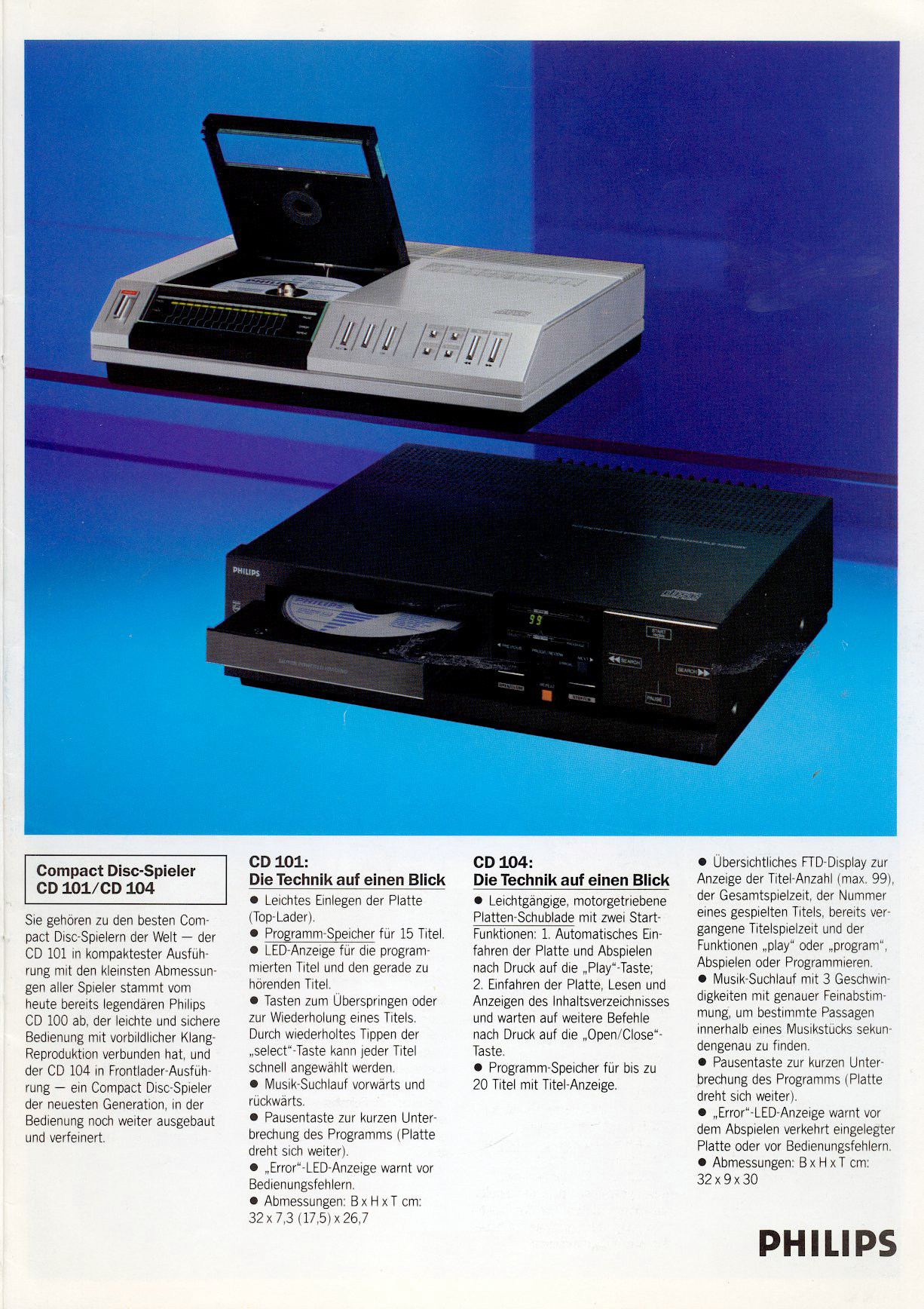Difference between revisions of "Philips CD 104"
| (8 intermediate revisions by 3 users not shown) | |||
| Line 1: | Line 1: | ||
| − | ''' | + | __NOTOC__ |
| + | == Data == | ||
| + | {{navigation}} | ||
| + | '''General''' | ||
| + | * Manufacturer: [[Philips]] | ||
| + | * Model: CD 104 | ||
| + | * Type: CD-Player | ||
| + | * Years of manufacture: 1983 - 1985 | ||
| + | * Made in: Belgium | ||
| + | * Colour: Silver/Brown | ||
| + | * Remote control: no | ||
| + | * Power consumption: 30 W | ||
| + | * Dimensions: 320 x 90 x 300mm (WxHxD) | ||
| + | * Weight: 7 kg | ||
| + | * Original price approx.: 1'150 DM (1984) <ref>[http://www.cd-museum.de/14-hardware/184-cd-die-player-cd Price in 1984]</ref>. | ||
| − | |||
| − | |||
| − | |||
| − | |||
| − | |||
| − | |||
| − | |||
| − | ''' | + | '''Technical data''' |
| + | * 2 channels | ||
| + | * Frequency range: 20 - 20,000 Hz | ||
| + | * Dynamic range: 96 dB | ||
| + | * Noise margin: 96 dB | ||
| + | * Channel separation: 64 dB at 1,000 Hz | ||
| + | * Distortion attenuation: 0.003 % at 1,000 Hz | ||
| + | * Uniformity: Quartz precision | ||
| + | * Digital/Analog Converter: 16 bit oversampling with digital filter and 14 bit D/A converter | ||
| + | * Error correction system: CIRC | ||
| + | * Audio output signal: 2 V rms | ||
| + | * Laser type: AlGaAs semiconductor | ||
| + | * Wavelength: 800 nm | ||
| + | * Sampling frequency: 4.1 kHz | ||
| + | * Quantization: 16 bit linear | ||
| + | * Mains voltage: 220 V | ||
| + | * Frequency: 50 and 60 Hz | ||
| + | * Power consumption: approx. 30 Watt | ||
| + | * Material and design: metal and polystyrene with aluminium trim parts | ||
| + | * Plate: diameter 120 mm | ||
| + | * Thickness: 1,2 mm | ||
| + | * Direction of rotation: left | ||
| + | * Scanning speed: 1,2 - 1,4 m/s | ||
| + | * Rotation speed: 500 - 200 rpm | ||
| + | * Track pitch: 1.6 um | ||
| − | |||
| − | + | == Remarks == | |
| − | + | * Other models in the same series: | |
| − | + | * [[Philips CD 101]] | |
| − | + | * [[Philips CD 104]] | |
| − | + | * [[Philips CD 202]] | |
| − | + | * [[Philips CD 303]] | |
| − | + | ||
| − | + | ||
| − | + | == Pictures == | |
| − | + | * Extract from brochure: Philips CD 101, CD 104 | |
| − | + | [[File:Philips CD-101-104-Prospekt-1984.jpg]] | |
| − | + | ||
| − | + | ||
| − | + | == Reports == | |
| − | + | * The two circuit boards have vias with hollow rivets that tear out over time. Tendency in old age to cracked ground connections<ref>[http://www.hifi-forum.de/viewthread-84-867.html Hifi-forum.de]</ref>. | |
| − | + | ||
| − | + | ||
| − | + | == Links == | |
| − | + | ||
| − | + | ||
| − | + | [[Category:CD Player]] | |
| − | |||
| − | |||
| − | |||
| − | |||
| − | |||
Latest revision as of 08:17, 24 September 2019
Data[edit]
General
- Manufacturer: Philips
- Model: CD 104
- Type: CD-Player
- Years of manufacture: 1983 - 1985
- Made in: Belgium
- Colour: Silver/Brown
- Remote control: no
- Power consumption: 30 W
- Dimensions: 320 x 90 x 300mm (WxHxD)
- Weight: 7 kg
- Original price approx.: 1'150 DM (1984) <ref>Price in 1984</ref>.
Technical data
- 2 channels
- Frequency range: 20 - 20,000 Hz
- Dynamic range: 96 dB
- Noise margin: 96 dB
- Channel separation: 64 dB at 1,000 Hz
- Distortion attenuation: 0.003 % at 1,000 Hz
- Uniformity: Quartz precision
- Digital/Analog Converter: 16 bit oversampling with digital filter and 14 bit D/A converter
- Error correction system: CIRC
- Audio output signal: 2 V rms
- Laser type: AlGaAs semiconductor
- Wavelength: 800 nm
- Sampling frequency: 4.1 kHz
- Quantization: 16 bit linear
- Mains voltage: 220 V
- Frequency: 50 and 60 Hz
- Power consumption: approx. 30 Watt
- Material and design: metal and polystyrene with aluminium trim parts
- Plate: diameter 120 mm
- Thickness: 1,2 mm
- Direction of rotation: left
- Scanning speed: 1,2 - 1,4 m/s
- Rotation speed: 500 - 200 rpm
- Track pitch: 1.6 um
Remarks[edit]
- Other models in the same series:
- Philips CD 101
- Philips CD 104
- Philips CD 202
- Philips CD 303
Pictures[edit]
- Extract from brochure: Philips CD 101, CD 104
Reports[edit]
- The two circuit boards have vias with hollow rivets that tear out over time. Tendency in old age to cracked ground connections<ref>Hifi-forum.de</ref>.
